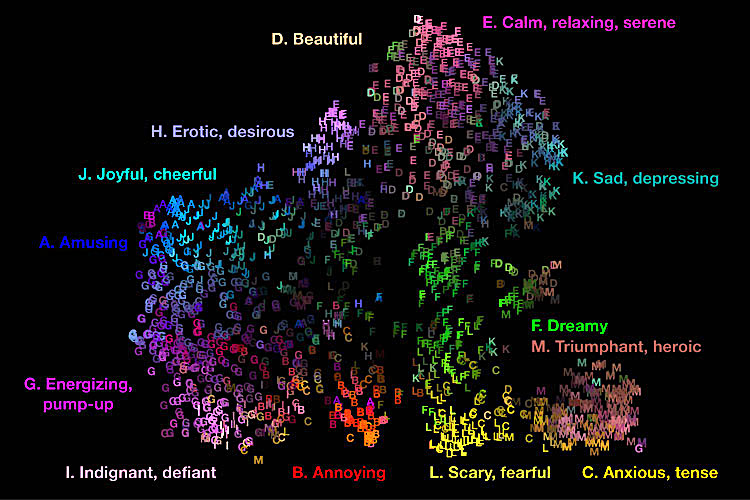
Most of our playlists today are filled with music about emotions: usually love, of course, but also excitement, defiance, anger, devastation, and a host of others besides. We listen to these songs in order to appreciate the musicianship that went into them, but also to indulge in their emotions for ourselves. As for what exactly evokes these feelings within us, lyrics only do part of the job, and perhaps a small part at that. In search of a more rigorous conception of which sonic qualities trigger which emotions in listeners — and a measurement of how many kinds of emotions music can trigger — scientists at UC Berkeley have conducted a cross-cultural research project and used the data to make an interactive listening map.
The study’s creators, a group including psychology professor Dacher Keltner (founding director of the Greater Good Science Center) and neuroscience doctoral student Alan Cowen, “surveyed more than 2,500 people in the United States and China about their emotional responses to these and thousands of other songs from genres including rock, folk, jazz, classical, marching band, experimental and heavy metal.” So writes Berkley News’ Yasmin Anwar, who summarizes the broader findings as follows: “The subjective experience of music across cultures can be mapped within at least 13 overarching feelings: Amusement, joy, eroticism, beauty, relaxation, sadness, dreaminess, triumph, anxiety, scariness, annoyance, defiance, and feeling pumped up.”
Many listener responses can’t have been terribly surprising. “Vivaldi’s ‘Four Seasons’ made people feel energized. The Clash’s ‘Rock the Casbah’ pumped them up. Al Green’s ‘Let’s Stay Together’ evoked sensuality and Israel (Iz) Kamakawiwoʻole’s ‘Somewhere over the Rainbow’ elicited joy.
Meanwhile, heavy metal was widely viewed as defiant and, just as its composer intended, the shower scene score from the movie Psycho triggered fear.” The cultural influence of Hitchcock, one might object, has by now transcended all boundaries, but according to the study even Chinese classical music gets the same basic emotions across to Chinese and non-Chinese listeners alike.
Still, all respectable art, even or perhaps especially an abstract one such as music, leaves plenty of room for personal interpretation. You can check your own emotional responses against those of the Berkeley survey’s respondents with its interactive listening map. Just roll your cursor over any of point on its emotional territories, and you’ll hear a short clip of the song listeners placed there. On the peninsula of category H, “erotic, desirous,” you’ll hear Chris Isaak, Wham!, and a great many saxophonists; down in the netherlands of category G, “energizing, pump-up,” Rick Astley’s immortalized “Never Gonna Give You Up” and Alien Ant Farm’s novelty cover of “Smooth Criminal.” Anwar also notes that “The Shape of You,” Ed Sheeran’s inescapable hit, “sparks joy” — but if I have to hear it one more time at the gym, I can assure you my own emotional response won’t be quite so positive.
Related Content:
Daniel Levitin Shows How Musicians Communicate Emotion
Watch Classical Music Get Perfectly Visualized as an Emotional Roller Coaster Ride
Neurosymphony: A High-Resolution Look into the Brain, Set to the Music of Brain Waves
Based in Seoul, Colin Marshall writes and broadcasts on cities, language, and culture. His projects include the Substack newsletter Books on Cities, the book The Stateless City: a Walk through 21st-Century Los Angeles and the video series The City in Cinema. Follow him on Twitter at @colinmarshall or on Facebook.


Leave a Reply